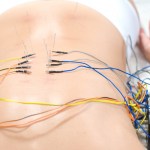meal
Image of a Mexican Jay selecting peanuts from www.sci-News.com
I just listened to a neat podcast from Scientific American's Karen Hopkin in which she described a new study published in the Journal of Ornithology that suggests Mexican Jays (Aphelocoma ultramarina) pick which peanut to eat only after literally weighing their options. The researchers modified some peanuts to remove the contents. The Mexican Jays were then offered unmodified nuts along with the empty shells. Perhaps not surprisingly, the birds snubbed the empty shells. Rather, they only chose…
Image of electroacupuncture to the back from www.sandiegohealingarts.com
A new study published in AJP-Regulatory, Integrative and Comparative Physiology suggests that electroacupuncture to the abdominal region may prevent increases in blood sugar concentrations after a meal by affecting insulin sensitivity and circulating free fatty acid concentrations. Granted this is not comparative physiology research, I find it interesting that electrical stimulation can have such a large impact on metabolism, in mice at least.
Drs. Nicola Abate and Jiande Chen, lead investigators…
A recent article published in the American Journal of Physiology reviewed how the brain regulates feeding behaviors. Humans are not the only species to eat food in spurts we like to call meals. Research suggests that this behavior may actually aid survival as it reduces exposure time to the environment and makes responding to fluctuations in the availability of food a bit easier to deal with. Dr. Marise Parent and colleagues at Georgia State University wanted to find out how your body determines when to initiate eating as well as how long the interval between meals should be.…
